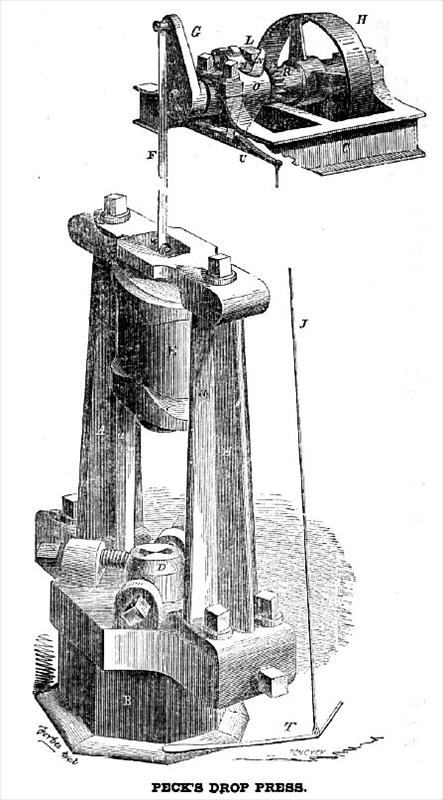|
Title: |
1856 Image-Milo Peck, Drop Press |
|
Source: |
Transactions of the American Institute of the City of New York 1856 pg 197 |
|
Insert Date: |
3/25/2011 8:05:46 PM |
|
A A are the standards or ways, between which the drop E with its die attached, moves; B is the bed or anvil, with the lower die secured in its place; C is the frame of the raising machinery, (with one corner removed to show the spring catch U;) G is the lift crank; F is a leather strap connecting the crank G by its pin with the drop E. The crank has holes in it to insert the pin at different points from the centre, to give a long or short stroke to the drop; 0 is a double crank, to one end of which is attached the dog L. There is an eccentric guard ring, (not seen,) which raises the dog from the teeth of the ratchet, when the drop is at its highest point, at the same time that the other end of the crank 0 strikes the catch U, (which is connected by the rod J, with the treadle T,) and is locked firmly in its place, as shown. While the ratchet with its huh R, upon which is keyed the pulley H, revolves loosely upon the crank shaft. When the workman presses upon the treadle T, the catch U is depressed, the lock crank is released and the drop falls, carrying around the shaft, with its crank, &c., until the drop is at its lowest point, when the dog L leaves the guard ring and is pressed into the teeth of the ratchet wheel by spring JV, and is carried around, raising the drop to its highest point, when it is again raised from the ratchet, (which continues to revolve,) and the crank is locked in its place, suspending the drop E by the strap F, to be again tripped. The machine is entirely self-acting, excepting when the drop is made to fall; when the operator places his foot on the treadle, and it strikes one blow or more, as he desires. Its construction is such that it is impossible for it to rebound and strike the second blow, thus spoiling the work. It is adapted to the heaviest as well as the finest ornamental work. When it is not convenient to place the machine over the drop, as in the cut, it may be placed to one side, when it is only necessary to alter the position of the crank G, and pass the strap F over a pulley. diploma awarded |
|
 1856 Milo Peck, Drop Press
1856 Milo Peck, Drop Press
|
|